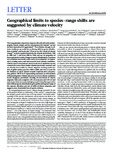Geographical limits to species-range shifts are suggested by climate velocity.
| dc.contributor.author | Burrows, MT | en |
| dc.contributor.author | Schoeman, DS | en |
| dc.contributor.author | Richardson, AJ | en |
| dc.contributor.author | Molinos, JG | en |
| dc.contributor.author | Hoffmann, A | en |
| dc.contributor.author | Buckley, LB | en |
| dc.contributor.author | Moore, PJ | en |
| dc.contributor.author | Brown, CJ | en |
| dc.contributor.author | Bruno, JF | en |
| dc.contributor.author | Duarte, CM | en |
| dc.contributor.author | Halpern, BS | en |
| dc.contributor.author | Hoegh-Guldberg, O | en |
| dc.contributor.author | Kappel, CV | en |
| dc.contributor.author | Kiessling, W | en |
| dc.contributor.author | O'Connor, MI | en |
| dc.contributor.author | Pandolfi, JM | en |
| dc.contributor.author | Parmesan, C | en |
| dc.contributor.author | Sydeman, WJ | en |
| dc.contributor.author | Ferrier, S | en |
| dc.contributor.author | Williams, KJ | en |
| dc.contributor.author | Poloczanska, ES | en |
| dc.date.accessioned | 2017-10-29T18:55:35Z | |
| dc.date.available | 2017-10-29T18:55:35Z | |
| dc.date.issued | 2014-03-27 | en |
| dc.identifier.uri | http://hdl.handle.net/10026.1/10115 | |
| dc.description.abstract |
The reorganization of patterns of species diversity driven by anthropogenic climate change, and the consequences for humans, are not yet fully understood or appreciated. Nevertheless, changes in climate conditions are useful for predicting shifts in species distributions at global and local scales. Here we use the velocity of climate change to derive spatial trajectories for climatic niches from 1960 to 2009 (ref. 7) and from 2006 to 2100, and use the properties of these trajectories to infer changes in species distributions. Coastlines act as barriers and locally cooler areas act as attractors for trajectories, creating source and sink areas for local climatic conditions. Climate source areas indicate where locally novel conditions are not connected to areas where similar climates previously occurred, and are thereby inaccessible to climate migrants tracking isotherms: 16% of global surface area for 1960 to 2009, and 34% of ocean for the 'business as usual' climate scenario (representative concentration pathway (RCP) 8.5) representing continued use of fossil fuels without mitigation. Climate sink areas are where climate conditions locally disappear, potentially blocking the movement of climate migrants. Sink areas comprise 1.0% of ocean area and 3.6% of land and are prevalent on coasts and high ground. Using this approach to infer shifts in species distributions gives global and regional maps of the expected direction and rate of shifts of climate migrants, and suggests areas of potential loss of species richness. | en |
| dc.format.extent | 492 - 495 | en |
| dc.language | eng | en |
| dc.language.iso | eng | en |
| dc.subject | Animal Migration | en |
| dc.subject | Animals | en |
| dc.subject | Australia | en |
| dc.subject | Biodiversity | en |
| dc.subject | Climate | en |
| dc.subject | Climate Change | en |
| dc.subject | Ecosystem | en |
| dc.subject | Geographic Mapping | en |
| dc.subject | Geography | en |
| dc.subject | Models, Theoretical | en |
| dc.subject | Population Dynamics | en |
| dc.subject | Seawater | en |
| dc.subject | Temperature | en |
| dc.subject | Time Factors | en |
| dc.subject | Uncertainty | en |
| dc.title | Geographical limits to species-range shifts are suggested by climate velocity. | en |
| dc.type | Journal Article | |
| plymouth.author-url | https://www.ncbi.nlm.nih.gov/pubmed/24509712 | en |
| plymouth.issue | 7493 | en |
| plymouth.volume | 507 | en |
| plymouth.publication-status | Published | en |
| plymouth.journal | Nature | en |
| dc.identifier.doi | 10.1038/nature12976 | en |
| plymouth.organisational-group | /Plymouth | |
| plymouth.organisational-group | /Plymouth/Faculty of Science and Engineering | |
| plymouth.organisational-group | /Plymouth/REF 2021 Researchers by UoA | |
| plymouth.organisational-group | /Plymouth/REF 2021 Researchers by UoA/UoA07 Earth Systems and Environmental Sciences | |
| dc.publisher.place | England | en |
| dcterms.dateAccepted | 2013-12-30 | en |
| dc.identifier.eissn | 1476-4687 | en |
| dc.rights.embargoperiod | Not known | en |
| rioxxterms.versionofrecord | 10.1038/nature12976 | en |
| rioxxterms.licenseref.uri | http://www.rioxx.net/licenses/all-rights-reserved | en |
| rioxxterms.licenseref.startdate | 2014-03-27 | en |
| rioxxterms.type | Journal Article/Review | en |


